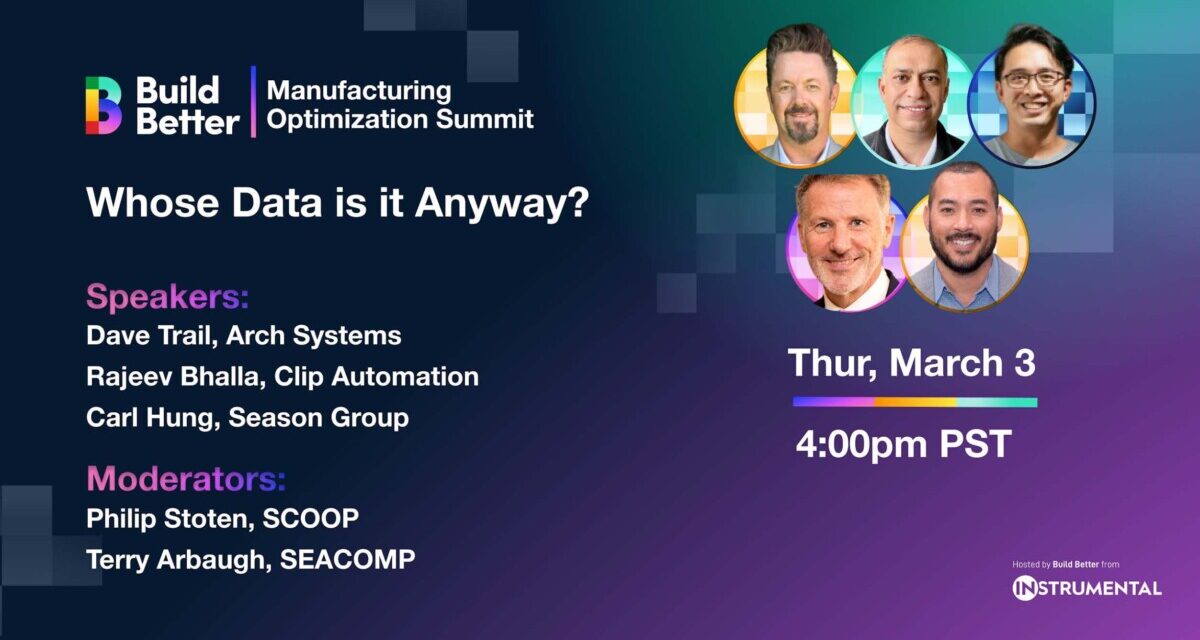Whose Data is it Anyway – A Build Better 2022 Panel

Wow, that was a lot of information, in fact that was a lot of data! Thanks to everyone who took part in Build Better 2022 which finished at 4pm pacific, today, Thursday, March 3rd. The subtitle of today’s conference was “The Criticality of Manufacturing Data as Infrastructure” and there is no doubt that data as infrastructure, and not as a tool, is the key to the future of manufacturing.
I was lucky enough to have the opportunity to chair a panel during today’s event entitled, “Whose Data is it Anyway”. The manufacturing process generates a lot of valuable data, a lot of it latent and untapped. Design data, product data, process data, worker data, product telemetry, return data… Everyone in the process can benefit from this data, but who gets to decide who does? The answer really matters.
I was delighted to be joined by co-host VP of Sales and Marketing at SEACOMP Terry Arbaugh and three great panelists, all of whom I have known for sometime and consider experts in their field with a wealth of experience. Dave Trail, VP of Arch Systems has data running through his veins, check out his previous experience at MES and data driven, manufacturing focused software providers. Rajeev Bhalla, co-founder and CEO of Clip Automation has built automations solutions at Apple and Juul and is now working to connect machines and teams to derive insight from manufacturing data that can drive real value. Carl Hung, the President and CEO of Season Group, was able to bring the perspective of an EMS provider that has factories in all the world’s key geographies including Asia, the Americas and Europe. I’d encourage you to connect with these guys when you get the chance.
I’d recommend that anyone in manufacturing or product design and fulfillment watch the on-demand content for this and the other presentations when it’s available, you won’t be wasting your time! You can see the agenda for the whole day here. But in the meantime, here’s a little taste of what you missed in our session.
The panel opened by exploring the big question posed in the title, whose data is it? Answers varied, from ownership residing with those that pay for the data collection to those that have a role in that data collection. Ultimately the data collected is valuable to numerous participants in the manufacturing supply chain and ecosystem. Take the example of data collected by the inspection machines on the line, like SPI (solder Paste Inspection), X-ray, placement head images, AOI (Automatic Optical Inspection), thermal profiling equipment data, test results and other video and machine data. This data may help the manufacturer improve their own performance, reduce waste, increase yield and eventually deliver value to their bottom line, particularly relevant in an industry with low margins. But isn’t that data also very valuable to the OEM for both traceability and providing feedback that can accelerate new product introduction or resolve issues much faster.
In a time where real-world factory visits are no longer simple or cheap, and let’s face it they never were, data that allows remote engineering is essential.
With ownership comes responsibility and even liability, this is of course true with data. The panel explored the importance of reliable verifiable data in a factory setting and who might be responsible for the accuracy of data when ultimately that might be driving a product failure in the field that results in an expensive recall.
If data tells you your product is good, that data better be really good!
The panel also articulated that data needs to be contextualized and converted to insight so value can be achieved and delivered to all the stakeholders, and while one participant might be collecting the data for one purpose, that data could have additional value to other participants. Indeed the real value might not be derived from raw data, but from insight generated from that data. So, who owns the insight? Maybe not the person who generated the data, maybe the person who processed that data and created that added value.
That premise took the panel into a brief discussion around Data-as-a-Service, Insight-as-a-Service and even Value-as-a-Service. Weighty and theoretical topics that can’t be solved in less than thirty minutes, even with such illustrious and thoughtful minds.
What about data transparency, how much do we want?
Data transparency may feel like a radical shift in an industry that has traditionally not shared data between suppliers, EMS providers, and brands. Ideally every stakeholder in the ecosystem should contribute to capturing that data and have the ability to derive insights and value from it. But how much information is too much information, and are we at risk of oversharing. The idea of the glass factory has been around for a while, but the panel felt unsure about the risks and liabilities of complete data transparency. Perhaps data translucency in the future, sharing data that is stripped of IP and is suitably anonymised.
I asked the panel for examples of great data sharing and, as I expected, few were forthcoming. This topic is a tricky one and there are no real systems, standards or guardrails in place for such open sharing. This is data sharing that would be valuable to everyone in the ecosystem to drive better outcomes, better products and better consumer experiences, not to mention making life simpler and a little more relaxed for those engineers designing and introducing new products.
Trends like D2C (Direct to Consumer) can only accelerate the need for more connected manufacturing ecosystems that respond quickly and autonomously to demand and disruption, the two things we have plenty of right now.
The panel wrapped up after a concise and insightful thirty minutes with some fascinating takeaways:
- Is the future Data-as-a-Service, Insight-as-a-Service, or even Value-as-a-Service? I’ve seen working examples of all three.
- Will large data players like SAP, Google and AWS provide the data infrastructure backbone needed?
- Will OEM’s demand for data find its way into the product specification shared with a contract manufacturer, or even onto the BOM (Bill of Materials)? I think this is a real possibility.
- Is unused, or dark data just noise if it’s not utilized? This idea comes with a warning, “be careful what data we discard, we may wish we hadn’t”
Sorry to end with more questions. This debate will continue in many formats and through many forums. Reach out on LinkedIn and share your own experiences and opinions. The bottom line is “there has never been a more important time to look at how your organization collects, shares and utilizes data”. Data is our infrastructure!
I’ll end with a comment in the chat window from a member of the audience, “Data is the difference between solvable and unsolvable problems.” I hope so!
Thank you Anna, the awesome team at Instrumental, the entire Build Better family, my co-host Terry and my three panelists Carl, Rajeev and Dave, you are all superstars!!












